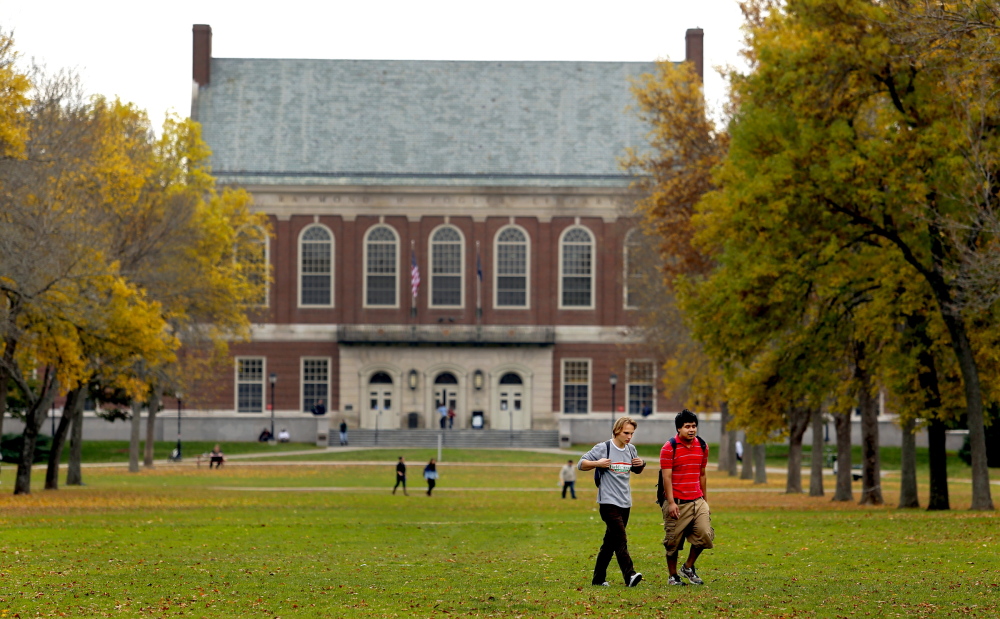ORONO — University of Maine officials announced Thursday that they must cut next year’s $242 million budget by $7 million, but will not eliminate any academic programs and will try to avoid layoffs.
“We really do want to minimize the impact on academic and student services,” Orono President Susan Hunter told about 200 people gathered in Minsky Recital Hall on the Orono campus.
“The goal is to avoid retrenchment (laying off employees),” she said. “That’s as explicit as I can be right now.”
Almost half of the cuts, $3.2 million, will come from academic affairs, which includes all the academic programming, officials said. Other major cuts will include $900,000 in administration and finance and $440,000 from the president’s office.
“The goal is to minimize the impact in student-centered areas,” said Ryan Low, vice president for administration and finance. Department heads will submit budgets that reflect the proposed cuts by Oct. 22, officials said.
The campus will also know on Oct. 20 how many faculty plan to retire.
The announcement comes in the wake of a plan proposed by University of Southern Maine President David Flanagan to eliminate 50 faculty positions and close two academic programs to shave $6 million off that school’s budget gap of $16 million for the next fiscal year. The remaining $10 million will come from administration and staff cuts, to be announced by mid-November, and a plan to reorganize academic programming, to be announced by the end of the year.
Last year, USM used $7 million in emergency funds to help close a $14 million gap in the school’s $134 million budget for the fiscal year that began July 1.
Hunter noted that in addition to the proposed cuts, the Orono campus will also make investments in certain areas identified as “centers of excellence,” such as engineering, marine science and climate change.
“We must continue to make some strategic investments,” Hunter said. “We have to be thinking ahead so we’re not just planning for this budget but we’re planning for the years to come.”
Last year, then-UMaine President Paul Ferguson balanced the $249 million budget by using almost $1 million in emergency system funds and cutting about $10 million by leaving positions vacant and laying off about seven non-faculty employees.
On Thursday, Orono Professor Eleanor Groden, the director of the school of biology and ecology, said she was waiting to see the final proposal that will include specifics on the cuts.
“It’s not to the level of detail to evaluate it or know what the impacts will be,” Groden said after the presentation. “The devil will be in the details.”
Officials noted some bright spots. Unlike most of the system universities, Orono has increased enrollment for the past two years.
Executive Vice President and Provost Jeff Hecker noted that Orono has increased the number of out-of-state students, who pay more in tuition.
“That’s very good news with respect to our budget,” Hecker said.
Like other campuses, Orono’s biggest expense is its people: $159 million in compensation and benefits, making up 66 percent of expenses. On the revenue side, 55 percent comes from tuition, about $134 million, and 33 percent from the state appropriation of $80.2 million.
English department chairman Richard Brucher said he was not surprised that officials were looking to make cuts without layoffs.
“This administration, particularly Jeff Hecker, has been protective of people who are in place,” Brucher said. “I was very gratified to hear it.”
Other UMS campuses are also in the process of developing their budgets. All seven campuses are expected to present their budget proposals to the University of Maine System board of trustees in January.
For years, the system has faced budget deficits, which officials say are the result of flat state funding, declining enrollment and three years of tuition freezes.
The University of Maine System faces a projected $69 million deficit by 2019, and in the most recent budget approved in May, officials cut 157 positions and used $11.4 million in emergency funds to close a $36 million deficit in the system’s $529 million budget. All seven campuses have made deep cuts to staff, not replaced retired faculty, put off capital improvements and cut sports teams.
This fall, system officials announced that they will be asking the Legislature to increase state funding by 3.4 percent, from $176.2 million to $182.2 million, for the fiscal year ending June 2016, and by 3.8 percent, to $189.1 million, for the following fiscal year.
Staff Writer Noel K. Gallagher can be contacted at 791-6387 or at:
Send questions/comments to the editors.



